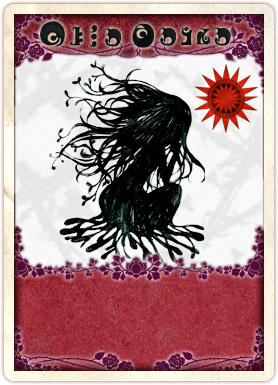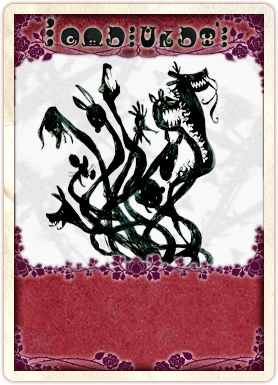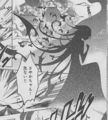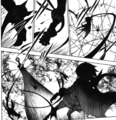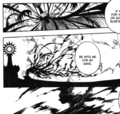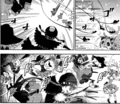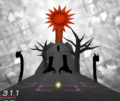Elsa Maria: Difference between revisions
No edit summary |
No edit summary |
||
| Line 1: | Line 1: | ||
'''Elsa Maria''' ({{Runes|ELSAMARIA}}) is a [[witch]] who battles [[Sayaka]] at the end of [[Episode 7]]. | '''Elsa Maria''' ({{Runes|ELSAMARIA}}) is a [[witch]] who battles [[Sayaka]] at the end of [[Episode 7]]. She reappears in [[Madoka Magica Portable]] and [[Madoka Magica Mobage]]. Her familiars make an appearance in [[The Rebellion Story]] and [[Magia Record]] | ||
==Witch Card== | ==Witch Card== | ||
{{Card | {{Card | ||
| Line 24: | Line 23: | ||
|episodes = [[Episode 7]], [[The Rebellion Story]] | |episodes = [[Episode 7]], [[The Rebellion Story]] | ||
}} | }} | ||
==History== | |||
===Original Anime=== | |||
Elsa Maria appears at the end of [[Episode 7]] where she fights [[Sayaka]]. [[Madoka]] accompanies her and [[Kyoko]] arrives to help. Elsa Maria uses an attack where a thick tree grows out of her back to stop Sayaka growing close to her. She is swiftly defeated due to Sayaka's emotional state, she hacks at her mercilessly with blood spurting out of the witch. Her [[Grief Seed]] is shown after the fight. Sayaka rejects it and gives it to Kyoko. | |||
===The Rebellion Story=== | |||
While Elsa Maria doesn't make a reappearance in [[The Rebellion Story]], her familiars do. [[Nagisa]] rides on them during the fight against {{Spoiler|Homulilly}}. | |||
==Observations== | ==Observations== | ||
*She is named after [https://en.wikipedia.org/wiki/Elsa_Asenijeff Elsa Asenijeff], also known as Elsa Maria Packeny. After refusing many proposals, she was forced by her parents to marry a diplomat eleven years her senior; She felt at the mercy of her husband, a theme that influenced her literary works. She eventually divorced the diplomat and remarried an artist, though this marriage too suffered when her second husband took an 18-year-old girl named Gertrude Bock as a model and companion, whom he eventually married shortly before his death after he and Asenijeff also divorced. After this divorce, she lived in poverty as her second ex-husband refused to support her financially; she eventually became isolated from her friends and family and was admitted to a psychiatric clinic | *She is named after [https://en.wikipedia.org/wiki/Elsa_Asenijeff Elsa Asenijeff], also known as Elsa Maria Packeny. After refusing many proposals, she was forced by her parents to marry a diplomat eleven years her senior; She felt at the mercy of her husband, a theme that influenced her literary works. She eventually divorced the diplomat and remarried an artist, though this marriage too suffered when her second husband took an 18-year-old girl named Gertrude Bock as a model and companion, whom he eventually married shortly before his death after he and Asenijeff also divorced. After this divorce, she lived in poverty as her second ex-husband refused to support her financially; she eventually became isolated from her friends and family and was admitted to a psychiatric clinic | ||
* | *Her name is possibly a reference to the song Ave Maria which [[Kyousuke Kamijou]] is known to play | ||
* | *She could also be a reference to Jeanne d'Arc, another magical girl (as shown in episode 12.) Jeanne said she was hearing the voices of saints, angels and God, and prayed very often | ||
*Elsa Maria | *Elsa Maria may be linked to [[wikipedia:Kakure_Kirishitan|Kakure Kirishitan]] (or "Hidden Christians") which were a group of practicing Christians that existed in hiding from the mid 1600's and on. Freedom of Religion was finally granted to Japanese citizens in 1871, which may have been the result of a wish. This would explain the heavily religious nature of the witch. | ||
**This can be an accurate theory because witches can not only live forever if never killed, which in this case would be difficult because of how she can only be defeated by a magical girl "with the blackest anguish," but they can also live on as familiars that break away and grow back into witches. Not all witches are necessarily new, they can survive for a very long time and duplicate if a part is broken off. | **This can be an accurate theory because witches can not only live forever if never killed, which in this case would be difficult because of how she can only be defeated by a magical girl "with the blackest anguish," but they can also live on as familiars that break away and grow back into witches. Not all witches are necessarily new, they can survive for a very long time and duplicate if a part is broken off. | ||
** On the other hand, Elsa Maria could be a modern Japanese Christian, possibly a descendant of the ''Kakure Kirishitan'' and/or just ''very'' influenced by their history and martyrdom (like real life writer [[wikipedia:Shusaku_Endo|Shusaku Endo]], who was Catholic). She might be from either [[wikipedia:Nagasaki|Nagasaki]] (the city with the biggest historical connection with Japanese Catholicism, and one of the places where the ''Kakure Kirishitan'' came from), [[wikipedia:Akita|Akita]] (the prefecture where the Marian apparitions known as [[wikipedia:Our_Lady_of_Akita|Our Lady of Akita]] took place) or the Madoka world's equivalent to Nagasaki and Akita. | ** On the other hand, Elsa Maria could be a modern Japanese Christian, possibly a descendant of the ''Kakure Kirishitan'' and/or just ''very'' influenced by their history and martyrdom (like real life writer [[wikipedia:Shusaku_Endo|Shusaku Endo]], who was Catholic). She might be from either [[wikipedia:Nagasaki|Nagasaki]] (the city with the biggest historical connection with Japanese Catholicism, and one of the places where the ''Kakure Kirishitan'' came from), [[wikipedia:Akita|Akita]] (the prefecture where the Marian apparitions known as [[wikipedia:Our_Lady_of_Akita|Our Lady of Akita]] took place) or the Madoka world's equivalent to Nagasaki and Akita. | ||
*The tree growing from Elsa Maria's back may be a reference to the Biblical tale of Adam & Eve. The familiars could be a reference to the animals in The Garden of Eden | *The tree growing from Elsa Maria's back may be a reference to the Biblical tale of Adam & Eve. The familiars could be a reference to the animals in The Garden of Eden | ||
*There is possibility that Elsa Maria is praying for America to end World War II, given the Statue of Liberty-like image in her labyrinth. The dead tree look of her attacks may reference the effect of the fallout radiation from the nuclear bomb that was dropped on Japan. Her minions also are representative of the twelve zodiac, which may imply the transition after World War II from Eastern thought to the Western thought that happened after World War II | *There is possibility that Elsa Maria is praying for America to end World War II, given the Statue of Liberty-like image in her labyrinth. The dead tree look of her attacks may reference the effect of the fallout radiation from the nuclear bomb that was dropped on Japan. Her minions also are representative of the twelve zodiac, which may imply the transition after World War II from Eastern thought to the Western thought that happened after World War II | ||
==Trivia== | ==Trivia== | ||
*[[Puella_Magi_Madoka_Magica_Official_Guidebook_"You_Are_Not_Alone"#Labyrinth_design|The Guidebook]] indicates that Elsa Maria's labyrinth design is a Church, with the words ''"I wish you, although not seen from me, to be happy."'' (まだ見ないあなたが幸せであるように). It indicates when the Witch dies, the stained glass collapses and drops into the air. There's a 'baaaaaaahn' sound like from a pipe organ | *[[Puella_Magi_Madoka_Magica_Official_Guidebook_"You_Are_Not_Alone"#Labyrinth_design|The Guidebook]] indicates that Elsa Maria's labyrinth design is a Church, with the words ''"I wish you, although not seen from me, to be happy."'' (まだ見ないあなたが幸せであるように). It indicates when the Witch dies, the stained glass collapses and drops into the air. There's a 'baaaaaaahn' sound like from a pipe organ | ||
==Gallery== | ==Gallery== | ||
Revision as of 17:05, 23 November 2020
Elsa Maria (ELSAMARIA) is a witch who battles Sayaka at the end of Episode 7. She reappears in Madoka Magica Portable and Madoka Magica Mobage. Her familiars make an appearance in The Rebellion Story and Magia Record
Witch Card
The witch of shadow with a self-righteous nature. She continually prays for all of creation and drags all life equally into her shadow without breaking her posture. One hoping to defeat her must know the blackest anguish. | |||||||||||
Minions
The shadow witch's minions, whose duty is to blindly believe. They are an aggregate of the lives who have found salvation thanks to the shadow witch. They continually seek out companions. | |||||||||||
History
Original Anime
Elsa Maria appears at the end of Episode 7 where she fights Sayaka. Madoka accompanies her and Kyoko arrives to help. Elsa Maria uses an attack where a thick tree grows out of her back to stop Sayaka growing close to her. She is swiftly defeated due to Sayaka's emotional state, she hacks at her mercilessly with blood spurting out of the witch. Her Grief Seed is shown after the fight. Sayaka rejects it and gives it to Kyoko.
The Rebellion Story
While Elsa Maria doesn't make a reappearance in The Rebellion Story, her familiars do. Nagisa rides on them during the fight against Homulilly.
Observations
- She is named after Elsa Asenijeff, also known as Elsa Maria Packeny. After refusing many proposals, she was forced by her parents to marry a diplomat eleven years her senior; She felt at the mercy of her husband, a theme that influenced her literary works. She eventually divorced the diplomat and remarried an artist, though this marriage too suffered when her second husband took an 18-year-old girl named Gertrude Bock as a model and companion, whom he eventually married shortly before his death after he and Asenijeff also divorced. After this divorce, she lived in poverty as her second ex-husband refused to support her financially; she eventually became isolated from her friends and family and was admitted to a psychiatric clinic
- Her name is possibly a reference to the song Ave Maria which Kyousuke Kamijou is known to play
- She could also be a reference to Jeanne d'Arc, another magical girl (as shown in episode 12.) Jeanne said she was hearing the voices of saints, angels and God, and prayed very often
- Elsa Maria may be linked to Kakure Kirishitan (or "Hidden Christians") which were a group of practicing Christians that existed in hiding from the mid 1600's and on. Freedom of Religion was finally granted to Japanese citizens in 1871, which may have been the result of a wish. This would explain the heavily religious nature of the witch.
- This can be an accurate theory because witches can not only live forever if never killed, which in this case would be difficult because of how she can only be defeated by a magical girl "with the blackest anguish," but they can also live on as familiars that break away and grow back into witches. Not all witches are necessarily new, they can survive for a very long time and duplicate if a part is broken off.
- On the other hand, Elsa Maria could be a modern Japanese Christian, possibly a descendant of the Kakure Kirishitan and/or just very influenced by their history and martyrdom (like real life writer Shusaku Endo, who was Catholic). She might be from either Nagasaki (the city with the biggest historical connection with Japanese Catholicism, and one of the places where the Kakure Kirishitan came from), Akita (the prefecture where the Marian apparitions known as Our Lady of Akita took place) or the Madoka world's equivalent to Nagasaki and Akita.
- The tree growing from Elsa Maria's back may be a reference to the Biblical tale of Adam & Eve. The familiars could be a reference to the animals in The Garden of Eden
- There is possibility that Elsa Maria is praying for America to end World War II, given the Statue of Liberty-like image in her labyrinth. The dead tree look of her attacks may reference the effect of the fallout radiation from the nuclear bomb that was dropped on Japan. Her minions also are representative of the twelve zodiac, which may imply the transition after World War II from Eastern thought to the Western thought that happened after World War II
Trivia
- The Guidebook indicates that Elsa Maria's labyrinth design is a Church, with the words "I wish you, although not seen from me, to be happy." (まだ見ないあなたが幸せであるように). It indicates when the Witch dies, the stained glass collapses and drops into the air. There's a 'baaaaaaahn' sound like from a pipe organ
Gallery
Official Art
Art of Elsa Maria from the Puella Magi Production Note
Art featuring Elsa Maria and Sebastian from the Key Animation Note volume 6
Memoria card from Magia Record
Screenshots
The Rebellion Story
Sebastian in The Rebellion Story
Manga
Elsa Maria in the manga
Elsa Maria in The Different Story
Sebastian in the Rebellion Manga
Madoka Magica Portable
Elsa Maria's Grief Seed from Puella Magi Madoka Magica Portable
Madoka Magica Mobage
Art of Elsa Maria from Madoka Magica Mobage
External links
- Elsa Maria card at official website (Japanese)
- Sebastian's card at official website (Japanese)
- Elsa Maria pixiv fanart
